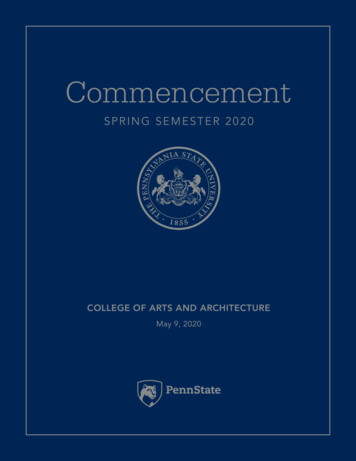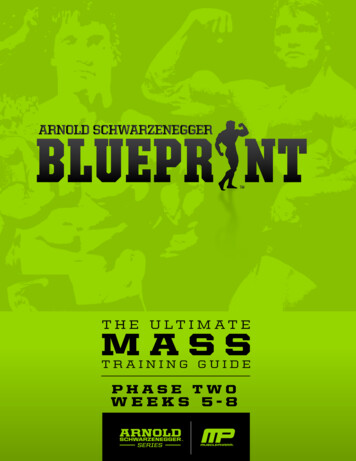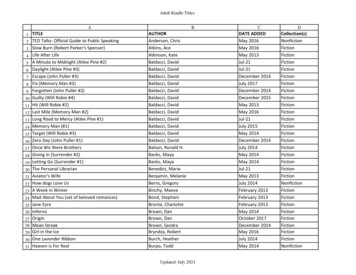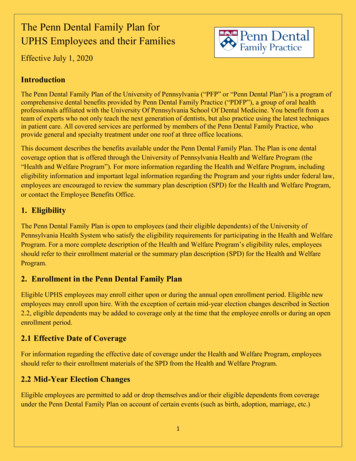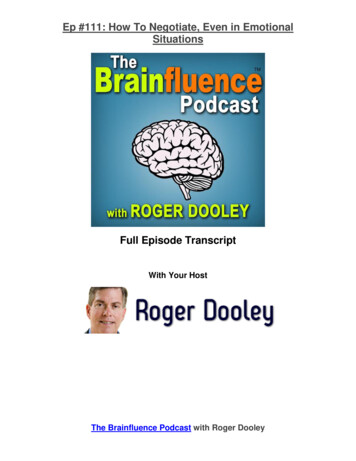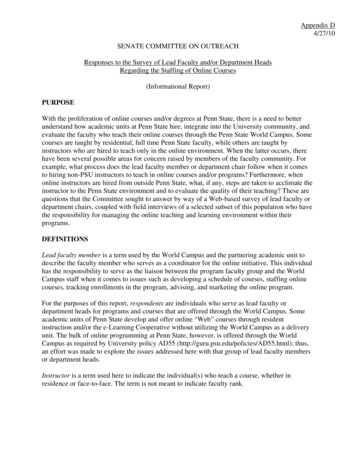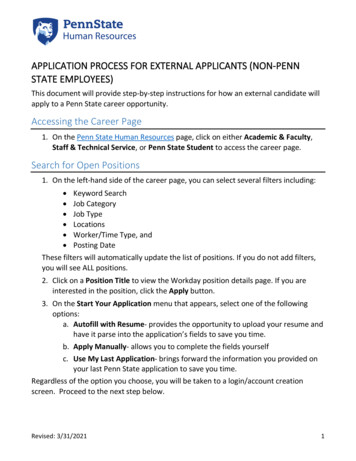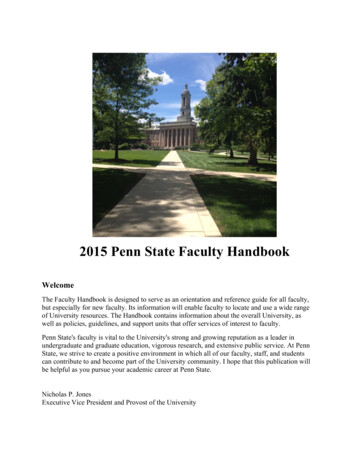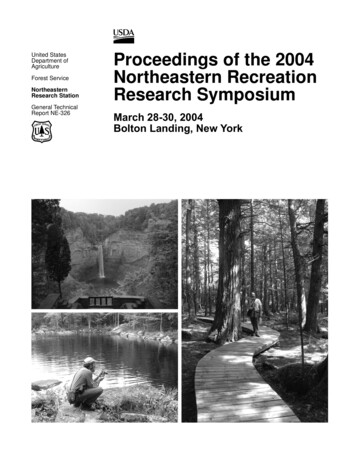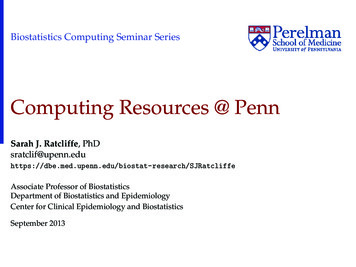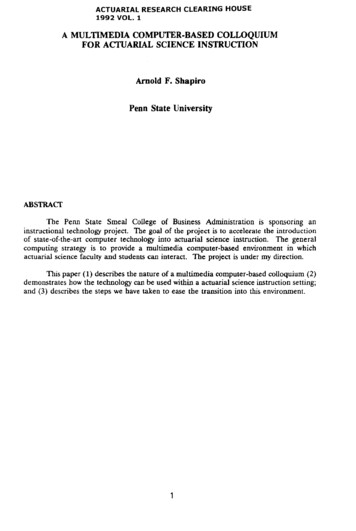
Transcription
A C T U A R I A L RESEARCH C L E A R I N G HOUSE1 9 9 2 VOL. 1A MULTIMEDIA COMPUTER-BASED COLLOQUIUMFOR ACTUARIAL SCIENCE INSTRUCTIONArnold F. ShapiroPenn State UniversityABSTRACTThe Penn State Smeal College of Business Administration is sponsoring aninstructional technology project. The goal of the project is to accelerate the introductionof state-of-the-art computer technology into actuarial science instruction. The generalcomputing strategy is to provide a multimedia computer-based environment in whichactuarial science faculty and students can interact. The project is under my direction.This paper (1) describes the nature of a multimedia computer-based colloquium (2)demonstrates how the technology can be used within a actuarial science instruction setting;and (3) describes the steps we have taken to ease the transition into this environment.
A C T U A R I A L RESEARCH C L E A R I N G HOUSE1 9 9 2 VOL. 1A MULTIMEDIA COMPUTER-BASED COLLOQUIUMFOR ACTUARIAL SCIENCE INSTRUCTIONINTRODUCTIONThe Penn State Smeal College of Business Administration is sponsoring aninstructional technology project called "A MultiMedia Computer-based Colloquium forActuarial science" (MCC-AS). The goal of the project is to accelerate the introduction ofstate-of-the-art computer technology into actuarial science instruction.The general computing strategy is to provide a multimedia computer-basedenvironment in which actuarial science faculty and students can interact. A key componentof the strategy is to develop ways to: (1) ease the transition into this environment; and (2)simplify transferability of the technology. The measure of the success of the project is theextent to which this technology is integrated into the curriculum.The specific technical approach can be summarized as follows. The project ismultimedia in the sense that one of its integral components is an audio-visual interface,which incorporates sounds and pictures into an exposition. It is computer-based inasmuchas it incorporates: (1) a software construction set, which facilitates the construction ofrandom-access pedagogical modules; and (2) Microsoft Windows-based applications, whichenhance the users ability to respond dynamically to queries and to investigate suppositions.Sponsorship of the project is through a partnership involving IBM, the William ElliottChair of Insurance, and the Smeal College of Business Administration. The project is undermy direction.DESCRIPTION OF THE PROJECT PLATFORMThe elements of our MultiMedia Computer-based Actuarial Science Colloquium areshown in the following figure:3
IMuI Mcd Compumr-basedColloquium IFigure 1: An MCC for Actuarial ScienceThe core of the system is an IBM PS/2 processor, or compatible, operating withina Microsoft Windows-based environment, and equipped with a software construction set.As indicated (on the left side of the figure), a wide variety of standard sources ofaudio and visual input can be used to enhance the learning experience. The source of videocan be a video camera, videodisc, or videotape, while audio input can be from amicrophone, CD-ROM player, or tape/cassette unit.The devises which integrate the audio and visual effects into the instructionalmaterial is shown at the bottom right of the figure. The video capture devise and the audiocapture/playback work in conjunction with a software product that mixes and coordinatesthe incoming signals. The attraction of this arrangement is that it greatly simplifies theblending of image and audio capture with software production, authoring and presentationcapabilities. Consequently, even a novice can produce professional results.Finally, a Local Area Network (I.AN) can be used to provide a dynamic interactiveconnection between the instructor and the students.Of course, not all of these devises are needed to develop this type of computer-basedcolloquium for actuarial science instruction. However, the minimum configuration requiredis an IBM PS/2 processor, or compatible, operating within a Microsoft Windows-basedenvironment, and a software construction set.INNOVATIVE AND UNIQUE FEATURESThe discovery of innovative and unique features of a MCC-AS is an ongoing process,and we are constantly finding new, potentially fruitful areas to explore. Having said this,1 will limit my discussion to four representative features. The four features are: theinteractive data base; the coordination of the dimensions of a topic; bringing the "real world"
into the classroom; and examination and quizzes.Interactive Data BasesInteractive data bases are a integral part of our MCC-AS, since they are used toexplain, enhance, and dynamically analyze concepts during a classroom presentation. Anumber of different data bases can be developed. These include:1.Decrement data, involving such things as mortality and morbidity statistics;2.Historical data, such as information about notable figures like BenjaminGompertz, a prominent early actuary, and Elizur Wright, a prominent earlyinsurance commissioner;3.Dynamic data, such as the San Francisco earthquake;4.Mathematical equations, such as those used to compute the present value ofinsurance and annuities, and those used to compute risk factors; and5.Industry data bases, such as time series data underlying loss ratios andexpense ratios, company ratings, and other insurance statistics.Thus, the system gives an instructor the means to link associated ideas using acustomized data base. This means, for example, that, during a classroom presentation, youcan link the discussion of insurance company charters to a copy of the 1758 letter confirmingthe granting of the Charter of America's first life insurance company. A portion of thescreen which exhibits that document is shown in the following figure:i--.,Ii -/- . ---." -:- - . '-4]Figure 2: Linking Associated Ideas.This linking ability is an extremely helpful device. It opens up the classroom to anenvironment where conceptual time travel, and the exploration of distant enterprises and
abstract concepts, is a common occurrence. By so doing, it helps to hold the interest of thestudents, promote interaction, and, all-in-all, enhance the learning experience.Coordination of the Dimensions of a TopicOne of the strength of our system lies in the fact that it allows the instructor tocoordinate the different dimensions of a topic. This is exemplified by the following figure,which shows two electronic pages of one of the lectures from our Life Contingencies Icourse.Figure 3: Coordinating Dimensions.In this instance, the topic is whole life insurance, and the subtopic is net single premiums.The goal of the session is to convey the underlying concept, discuss the computational form,and analyze the dynamics of the function.The underlying concept and the computational form are discussed on the left-side ofthe screen. A succinct narrative is given at the bottom of the screen. On the right-side ofthe screen, the dynamics of the function are investigated. Here, the impact of usingdifferent mortality tables and/or different interest rates is tested. As indicated by the"more.," further information on this topic is given on a subsequent screen.A further item of note is that the menu at the top of the screen include the items"HotWords" and "Topics." By clicking "HotWords," the Reader can highlight special wordson the page, which can, themselves, be clicked to obtain further information or clarification,or to activate an audio/video interface. In this instance, for example, "Net" is a hotword,as is the symbol. Clicking "Topics" will display all the topics in this particular book.While packages of this type were created for classroom presentation, they also lendsthemselves to independent learning. In response to student requests, portions of thepackages can be accessed from public terminals at the College. Students can use thepackages for independent study and to reinforce class presentations.
The "Real World' Comes to the ClassroomOne of the shortcomings practitioners invariably attribute to universities, is that the"real world" is not reflected in the classroom. Students, they claim cannot get a feel for anoccupation or a sense of the workplace.Full motion video can help overcome this problem. In fact, the resolution of thisissue is one of the important features that makes the multimedia environment unique.Using this facility, your computer can receive and display full-motion video images fromvideodiscs, video cameras, closed circuit television or VCRs. By the same token, video stillscan be captured and stored on the computer's hard disk for subsequent integration into thepresentation. Thus, full motion videos and stills of the "real world" can be brought into theclass room.The following figure shows an example of the application of full motion video. Inthis instance, the person depicted is discussing the role of underwriting in insurance.Figure 4: The ' Real World"As suggested by the controls at the bottom of the figure, the user has considerable discretionover a video. Options available through the computer include running the video forwardand backwards, at various speeds; changing the volume; choosing a particular set of framesto be displayed; and exhibiting the text of the discussion.Examination and QuizzesThe standard form of examination and quiz computer data base is available in anMCC-AS environment. It is easily upgraded to incorporate new questions and providesrandom access to specific topics.As a complement to this data base, we have constructed an Examination Preparation
Laboratory (EPL), which students can use to test their knowledge on a subject and identifyareas where they are weak.Of course, this question and quiz data bank (including password-protected extension)is available to the instructor, and can be used to give classroom exam/nations and quizzes.It can also be used in classroom discussion, to project a discussion point on the screen andhave students respond via their personal keypads. This gives an immediate feedback as tothe extent of the class's understanding of the topic, and helps dynamically adaptpresentations to the needs of the class.DOCUMENTED EFFECTIVENESS AND SPECIFIC BENEFITS OF THE PROJECTMuch of the technology incorporated into this project is of relatively recent vintage.The software construction set, for example, did not formally appear on the market until thespring of 1990 and the audio-video facility is still referred to as a "new product".Nonetheless, there is strong evidence that an MCC-AS is an extraordinarily effectiveteaching tool.Perhaps, the best evidence of this comes from students. Since the project has beenunderway, numerous unsolicited students have volunteered to participate in the MCC-ASproject. Their interest has varied. In some instances, they were interested in "playing" withthe instruction modules; in other instances, they wanted to help build such modules; in stillother cases, they simply offered constructive criticism on how the MCC could be improvedor modified. As a general rule, graduate students are enthusiastic about using an MCC fortheir coursework presentations.This is not to say that there is no hard evidence on the potential effectiveness of aMCC. To the extent that our prior actuarial science instruction configurations were thebuilding blocks upon which our current configuration relies, there is a good deal ofdocumentation. The general thrust of prior and current student evaluation forms is that theMCC produces an interactive classroom environment that is conducive to learning andenhances the learning experience. A similar conclusion can be drawn for the self-studymodule of the MCC.There also is compelling indirect documented evidence of the success of an MCCenvironment. It is an outgrowth of the widely acclaimed technology that created the"Writing to Read" program, which thousands of elementary schools use to help teach theirkindergarten children to write what they can say and read what they have written. It is anenhancement of the successful HyperCard technology of the Macintosh. Lastly, it allows theactuarial science instructor to use and create courseware that can capture the imaginationof the video-games generation, and use to advantage their addiction to computer graphicsand simulation.
PROGNOSISDuring the last 15 years, I have used various computer-related technologies forinstructional purposes in actuarial science courses. This has included the use of mainframes,mini-computers, micro-computers, and an array of software, including the major languages,spreadsheets, text processors, and presentation software. The configuration depicted inFigure 1 is by far the most dynamic and productive one for actuarial science instruction thatI have ever been associated with. There is no question in my mind that a multimediacomputer-based colloquium will be an integral p a n of the state-of-the-art actuarial scienceclassroom of the future. Multimedia will have as large an impact on instruction as themicrocomputer.
The Penn State Smeal College of Business Administration is sponsoring an instructional technology project called "A MultiMedia Computer-based Colloquium for Actuarial science" (MCC-AS). The goal of the project is to accelerate the introduction of state-of-the-art computer technology into actuarial science instruction.

